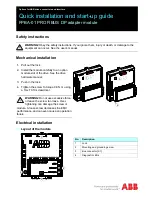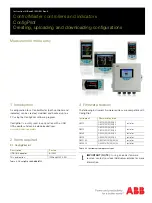
Installation Manual: PAD100-ZM Zone Module
NOTICE TO THE INSTALLER
This manual provides an overview and the installation instructions for the PAD100-ZM module. This module is only compatible with
addressable fire systems that utilize the PAD Addressable Protocol.
All terminals are power limited and should be wired in accordance with the requirements of NFPA 70 (NEC) and NFPA 72 (National
Fire Alarm Code). Failure to follow the wiring diagrams in the following pages will cause the system to not operate as intended. For
further information, refer to the control panel installation instructions.
The module shall only be installed with listed control panels. Refer to the control panel installation manual for proper system
operation.
1. Description
The PAD100-ZM uses one (1) SLC loop address when monitoring two (2) Class B or one (1) Class A circuit. The module is used to
supervise a zone of conventional 2-wire smoke detectors on an Initiating Device Circuit (IDC). The module requires and supervises
a 24VDC auxiliary power connection. The 24VDC power source must be either a Potter IPA series addressable panel, or a Potter
PSN series power supply. The IDC may be wired as two individual Class B circuits or one Class A circuit which is selectable by an
on board DIP switch. The module mounts on either an UL Listed 2-1/2" deep 2-gang box or 1-1/2" deep 4" square box.
The PAD100-ZM includes one red LED to indicate the module's status. In normal condition, the LED flashes when the device is
being polled by the control panel. When an input is activated, the LED will flash at a fast rate. If the LED blink has been disabled
via the programming software, in a normal condition the LED of the device will be off. All other conditions remain the same.
2. Setting the Address
All PAD protocol detectors and modules require an address prior to connection to the panel's SLC loop. Each PAD device's
address
(i.e., detector and/or module)
is set by changing the dip switches located on the device. PAD device addresses are
comprised of a
seven (7) position dip switch
used to program each device with an address ranging from 1–127.
Figure 1. PAD Device Dip Switch Addresses Table (Addresses 1
–
127)
Note:
Each
"gray" box
indicates that the dip switch is
"On,"
and each
"white" box
indicates
"Off."
The examples shown below illustrate a PAD device's dip switch settings: the 1st example shows a device
not addressed
where all
dip switch settings are in the
default
"Off" position
, the 2nd illustrates an
addressed PAD device
via the dip switch settings.
Figure 2. Examples of PAD Device Showing Default Dip Switch Setting (Unaddressed) & Addressed PAD Device
Off
On
1 2 4
16
8
32 64
All dip switches are
shown in the "Off"
position.
Off
On
1 2 4
16
8
32 64
Example shows this PAD device's
address = 42. Dip switches #2, 8 &
32 are in the "On" position.
Document 5406308
-A 02/16
Potter Electric Signal Company, LLC • St. Louis, MO • Phone: (800) 325-3936 • www.pottersignal.com
PAGE 1 OF 4
1 2 4 8 16 32 64
1 2 4 8 16 32 64
1 2 4 8 16 32 64
1 2 4 8 16 32 64
1 2 4 8 16 32 64
1
27
53
78
103
2
28
54
79
104
3
29
55
80
105
4
30
56
81
106
5
31
57
82
107
6
32
58
83
108
7
33
59
84
109
8
34
60
85
110
9
35
61
86
111
10
36
62
87
112
11
37
63
88
113
12
38
64
89
114
13
39
65
90
115
14
40
66
91
116
15
41
67
92
117
16
42
68
93
118
17
43
69
94
119
18
44
70
95
120
19
45
71
96
121
20
46
72
97
122
21
47
73
98
123
22
48
74
99
124
23
49
75
100
125
24
50
76
101
126
25
51
77
102
127
26
52
1 2 4 8 16 32 64
1 2 4 8 16 32 64
1 2 4 8 16 32 64
1 2 4 8 16 32 64
1 2 4 8 16 32 64
firealarmresources.com






















